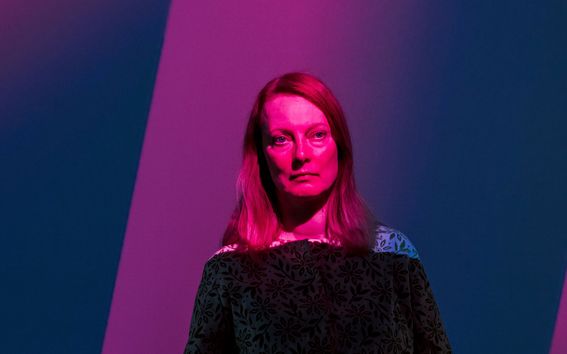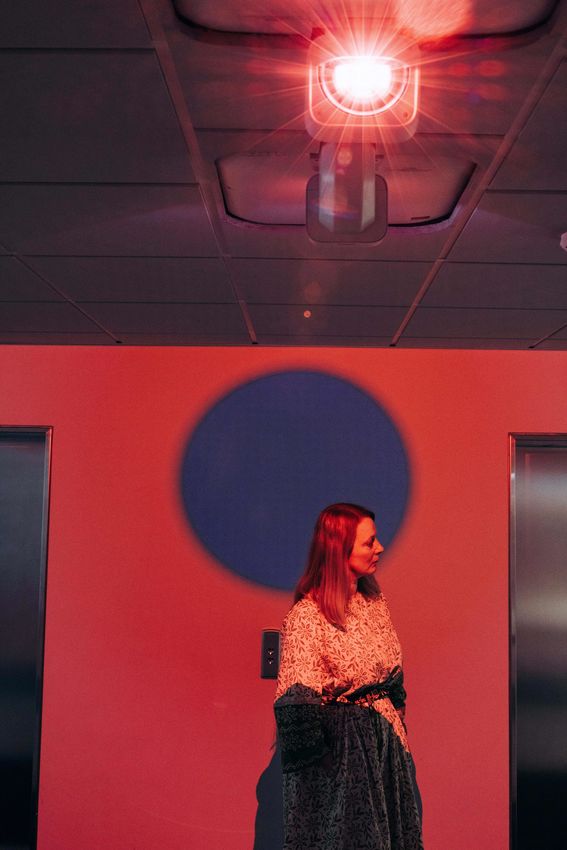Echoing a kindred spirit from a century past

When Alma Muukka-Marjovuo was working on her dissertation about Lilli Törnudd, she had no inkling that her career would align so closely with her research subject’s. By chance or destiny, that is exactly what came to be.
Törnudd was Chief Inspector for the Finnish National Agency for Education from 1918 to 1927, when it was called the National Board of General Education. Muukka-Marjovuo, in turn, was appointed as a Counsellor of Education to the Finnish National Agency for Education in 2020. She is responsible for basic education in the arts – after-school arts education provided by local art schools – and for dance and music in basic and general upper secondary education.
The foundation for her career was laid in the playgrounds of her childhood. Muukka-Marjovuo, who practices various forms of art, recalls with particular gratitude the long summer holidays, which now appear to her as a kind of lost paradise. As a child of two teachers, she got to spend summers at the cottage, free from any obligation.
‘We ran around naked, drew, painted and played music. If we happened to find some clay, we made wonderful art out of it.’
Second qualification helped career take off
It was her love for music that set Muukka-Marjovuo on the road to becoming an art professional. She started learning piano at age five and pursued it with determination, and she also played the flute.
After completing basic education, she attended Sibelius-lukio, an upper secondary school in Helsinki specialised in music and dance. From there, she went on to study music education at the Sibelius Academy, one of the largest music academies in Europe. A second-hand white grand piano followed her from one student apartment to another, and teaching at a music institute provided her with valuable work experience.
After graduating in 1993, Muukka-Marjovuo became a substitute teacher at her old secondary school, teaching music history, piano and chamber music. She enjoyed the school’s ethos and loved her job, but the Finnish recession in the 1990s cast a shadow of uncertainty over her future. A couple of years later, she decided to get a second qualification in visual arts education to improve her chances of getting a permanent position.
Being accepted into the University of Art and Design Helsinki (now Aalto University) was a stroke of luck for Muukka-Marjovuo. It helped her clinch the permanent position she wanted and, over time, culminated in her doctoral dissertation and a compelling career in administration.
A fortuitous find
After twenty years of teaching, Muukka-Marjovuo wanted to delve deeper into the heart of her profession. She found the subject for her research by accident when she stumbled upon a teaching methodology textbook by Törnudd, published in 1926, in the school attic.
Törnudd, a pioneer in drawing and crafts education, believed that ‘art should not be a subject but an educational principle.’ She aspired to position art and science as equals in the realm of education.
Initially, Muukka-Marjovuo planned to explore contemporary interdisciplinary teaching materials, but finding Törnudd made her reformulate her research question. She had discovered a kindred spirit from a hundred years ago; both were interested in the integration of different art disciplines.
‘Lilli wrote about interdisciplinarity in art during the early 1900s, a concept that is now considered a new trend. It was very avant-garde,’ she says.
Avant-garde approaches were also part of Muukka-Marjovuo’s dissertation process. She wanted to understand Törnudd’s era, personality, and methods by immersing herself in that world. She portrayed Törnudd on stage, experimented with Törnudd’s techniques with Aalto University art students, and even wore her grandmother’s black teaching gown from the 1920s.
‘I wanted to see how these more intuition-based, non-cognitive methods could be used in academia. From my current administrative perspective, that feels quite audacious,’ she says. ‘It was also interesting to notice how certain doctrines and areas of interest have a tendency to reappear in different historical periods.’
Making basic education in the arts visible
Muukka-Marjovuo completed her dissertation in 2014. After returning to her work at Sibelius-lukio and teaching history of art education at Aalto University for some years, it was time to embark on a new journey.
‘I’d been teaching for a long time and had also tried my hand at research, but the compensation from that isn’t sufficient to support a family. In life, thankfully, one thing leads to another – or perhaps it was Lilli’s ghost who snatched me onto this path,’ she says. Now, as Counsellor of Education, she spends her workdays offering guidance and dealing with developmental initiatives and administrative chores.
‘For a couple of years now, we’ve focused on strategy and quality management and developed metrics and data collection processes for basic education in the arts,’ she explains. ‘There’s an overwhelming amount of data collected from basic and secondary education, but basic education in the arts remains relatively unexplored.’
The first step is to get a full picture of the current situation. State-funded educational institutions are well documented, but not privately and municipally funded institutions. Now, Statistics Finland will start collecting data on institutions outside the state funding system. ‘Having a comprehensive understanding of the entire ecosystem is essential when making decisions about the development of this form of education as a whole.’
National strategic indicators to guide the quality of basic education in the arts will be published in 2023. By December, the Finnish National Agency for Education will also publish a new, user-oriented model so education providers can assess the quality of their services.
Several areas for improvement have been identified, including accreditation and registration of basic arts studies. From the beginning of 2023, these studies have been recorded in a centralised register, just like other academic achievements.
‘Now, the skills gained through extensive studies across diverse art disciplines are more visible when a student applies to upper secondary education or enters the job market,’ says Muukka-Marjovuo. ‘It’s a significant step.’
Local elements missing from curricula
The primary task of the Finnish National Agency for Education is to draft the national core curriculum. The next round of reforms will be the first in which Muukka-Marjovuo is involved right from the start.
Muukka-Marjovuo gained practical experience and insight into curriculum work through teaching and by contributing to Helsinki’s most recent municipal curriculum. Muukka-Marjovuo advocates for more local focus in municipal curricula, stressing the need to acknowledge a region’s strengths, natural and historical attributes, and socio-economic and cultural context.
She offers Lemi, where some of her family roots lie, as an example. ‘In their curriculum, they should include things like four-part singing as well as sustainable sheep farming and the Särä tradition,’ a traditional South Karelian lamb roast prepared using a thousand-year old recipe.
The most rewarding aspect of her work as Counsellor of Education is making things better through administrative changes, such as successfully campaigning for the equal recognition of different art disciplines. Muukka-Marjovuo is deeply invested in supporting people who need help and maintaining the abilities of people who are already doing well. She also enjoys on-site visits, networking and collaborative efforts.
Cultivating good citizenship through art education
Lilli Törnudd saw art education as a valuable catalyst to bridge societal divides, and she was involved in making art an integral part of school curricula. Compulsory courses in music and visual arts are now part of both basic and upper secondary education. ‘In Finland, the ethos of education maintains that art education is crucial to the development of a well-rounded citizen. Globally, this is a rarity,’ says Muukka-Marjovuo.
She shares Törnudd’s view that education, in all its forms, should encapsulate the spirit of investigation and questioning inherent in the realm of art. At its core, art has a unique ability to reshape thoughts and give a momentary view of life as a playful pastime that promotes well-being.
‘That vision is precisely what skilled art and music teachers pass on, alongside skills and techniques,’ she says. ‘And they preserve the connection to that childhood paradise.’

Alma Muukka-Marjovuo
- Graduated with a Master of Music degree from Sibelius Academy in 1993 and a Master of Arts degree from the University of Art and Design Helsinki (currently Aalto University) in 1998.
- Earned a Doctor of Arts degree from the Aalto University School of Arts, Design, and Architecture in 2014.
- Works as a Counsellor of Education at the Finnish National Agency for Education, where she is responsible for basic education in the arts and for dance and music in basic and general upper secondary education.
Is also
- An avid gardener: ‘My garden in Käpylä, Helsinki, is an important part of my well-being at work.’
- Member of a vocal ensemble: ‘We performed at the Kaustinen Folk Music Festival this summer. The ensemble mostly writes its own songs.’
- Versatile and adaptable art enthusiast: ‘When my children were young and time was scarce, I painted quick watercolours and wrote poems. As a secondary school art teacher, I had the opportunity to design and implement several stage sets with my students, and I also scripted and directed some plays. Now, my husband and I dance swing together. Playing the piano has always been a significant part of my life.’
Text: Annamari Typpö
Photos: Aleksi Poutanen
This article has been published in the Aalto University Magazine issue 33, September 2023.
- Published:
- Updated:
Read more news
Ashish Thapliyal: It’s amazing how small interactions can shape your career in unexpected ways
Ashish Thapliyal, a Doctoral Researcher at Aalto University, reflects on his unique educational journey and the valuable experiences he gained while studying at Aalto and Industrial Engineering and Management.
Appointments at the School of Chemical Engineering
The School of Chemical Engineering has appointed Jukka Hassinen as Development Manager and Sanna Hellstén as FinnCERES flagship Manager.
A community where personal connections and career paths intertwine
Assistant professor of operations management Siavash Khajavi explains how studying Industrial Engineering and Management helps students develop hard skills through rigorous studies and soft skills through countless interactions and collaboration.